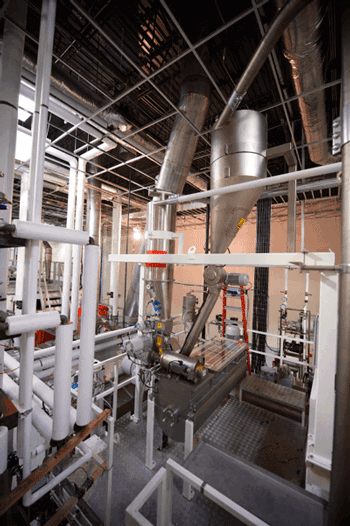Animal feed mixing is the heart and soul of any feed mill operation. Most feeds contain a range of raw ingredients that vary in size, shape, and consistency. The facility will need to break up and thoroughly mix these ingredients together to create a homogenous random mixture that’s uniform in size and shape. This ensures that every animal consumes the same amount of raw ingredients, otherwise these animals may start to develop at different rates or die prematurely.
Whether you’re designing a new feed mill construction or modifying an existing mill, you’ll want to spend time looking at efficiencies within the feed mixing process. Keep in mind the various considerations that go into creating the perfect mix and other feed processing tips that will help you keep your animals as healthy as possible.
CREATING THE PROPER MIX
The mixing process all starts with the animal feed recipe, which is a list of all the raw ingredients and their respective amounts used in the final mix. The animal feed engineer is responsible for coming up with the initial recipe. The main ingredients must be chosen and blended together in a way that ultimately benefits the health of the animals in question.
Every animal requires a unique type and size of feed. The engineer will need to make sure the resulting feed will keep the animals healthy based on their digestive needs, while increasing the quality and nutritional value of the foods these animals produce, such as meat, milk, and eggs.
The engineer or facility manager should also consider the different factors that will affect the overall quality of the animal feed when selecting their main ingredients.
FACTORS THAT WILL AFFECT THE QUALITY OF YOUR MIX
There are several things you can do to improve the nutritional value of your feed mix.
- Size and Shape
Before mixing your main ingredients together in the mixer, you need to make sure these raw materials are as close in size and shape as possible. For example, corn kernels are much larger and coarser than raw oats. You will need to grind up your main ingredients to make sure they all have the same size and shape before mixing them together.
Otherwise, raw oats may start to cluster around your corn kernels. Some of your animals may get more oats and less corn than others, leading to a range of health defects down the line. When checking the granulation of your source ingredients, your particles should not differ in size and shape by more than 3 millimetres.
- Weight
The same is true of the weight of your main ingredients. The smaller the differences between the specific weights of your particles, the better the mixing accuracy. If some of your ingredients or particles weigh more than others, they will likely sink to the bottom of the mixture, leaving you with a segregated mix that may ultimately harm your animals. The difference in the bulk density of your feed shouldn’t be more than around 0.5 kilograms per cubic meter or 31 pounds per cubic foot.
- Moisture
You also need to monitor moisture levels among your dry grain ingredients. Some products may contain more fluid than others, leading them to sweat during feed processing. If some particles or ingredients are moister than others, your feed may start to clump together.
If you are producing wet feed, it’s best to add moisture at the end of the mixing process to prevent lumping. Thoroughly mix your dry ingredients together first to make sure the mix is as homogenous as possible before adding water and other fluids.
- Type of Mixer
You should also consider the type of mixer you will use to produce your feed. There are many different types of feed mill mixers to choose from and each one will likely have a different effect on your feed. Horizontal mixers move feed across your facility, so they don’t pile on top of each other. Vertical mixers rely on gravity to move the feed downward, so the final mix piles on top of itself like sand in an hourglass. These slight variations will affect how your ingredients behave in the machine. Research different types of mixers to find the right feed processing equipment for your facility, based on the ingredients going into the machine and what kinds of animals you need to feed.
- Mixing Time
How long you mix your ingredients together will also have a bearing on the overall quality of your feed. Different types of industrial mixers require different mixing times. How long you mix also depends on the ingredients used in the recipe. Some models can produce uniform feeds in as little as 90 seconds, while others may need more time. If you mix your ingredients together too long or not long enough, the resulting mixture may not be homogenous.
- Accuracy
Use caution when measuring and loading your raw ingredients into the mixer. All measurements must be accurate to ensure a homogenous mass. If your scales are off by just a few grams or you load too much or too little of a certain ingredient, your feed may not be homogenous.
Keep these ideas in mind when coming up with the perfect recipe for your animals. Many different factors can affect the overall quality of your feed processing operations. Contact the professionals at Halverson Company for more grain handling information and a range of feed mill construction services.

